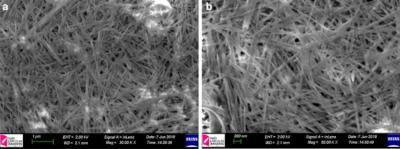Scientists from Turkey's Konya Technical University have shown that sepiolite, a naturally occurring clay substance, can be added to perovskite precursor materials, and form a scaffold layer that can improve the efficiency and stability of solar cells. The scientists believe that this substance could be valuable in developing reproducible processes for the production of large-area perovskite solar cells.
SEM image of aerosol coated sepiolite films on FTO glasses obtained from 1 mg/ml dispersion in water. (a) 30KX and (b) 50KX magnification. Image from study
The team found that sepiolite, a naturally occurring clay mineral largely composed of silicon, magnesium and oxygen, has a very high active surface area and can easily be dispersed in solvents. It can be used without any alterations as a scaffold layer in a perovskite solar cell. The group worked with planar perovskite solar cells with an initial maximum efficiency of 7.92%, and found that cells fabricated with the sepiolite additive jumped to a maximum efficiency just over 16%, more than a 50% increase for cells produced under otherwise identical conditions.
In the study, the team started by using a natural clay as scaffold layer in PSCs. It was observed that efficiency, reproducibility and stability of PSCs have been significantly improved. Improvements in efficiency have been observed to be between 30 and 50% depending on the type of perovskite solvent used. In addition, the surface chemistry of the sepiolite resulted in better crystallization as well as stability.
The group also found that since sepiolite is able to absorb a lot of water, it served to protect the moisture-sensitive inner layers of the perovskite cell from damage, both from residual water inside the cell and moisture from the atmosphere.
The group is convinced that sepiolite can be a useful additive in the search for large-area perovskite devices that can be manufactured at scale. “a natural clay sepiolite as scaffold layer in PSCs leads efficient, reproducible and stable PSCs,” the group stated. “Nontoxic chemical structure, low-cost availability in nature and facile processability of sepiolite may encourage researchers for large area fabrication of PSCs.”




